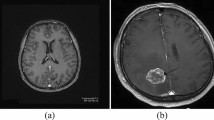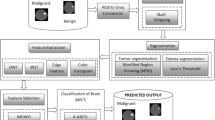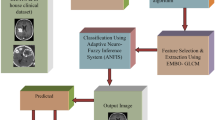Abstract
In medical Image processing, the chief objective is to detect Neoplasm effectively. Neoplasm is basically a sort of abnormal excessive cell growth but when it generates a mass, it is referred as tumors. Brain tumor (BT) is a deadly disease and also it is regarded as a common sort of cancer on adults and even on children. Therefore, early recognition of the correct sort of BT is significant for devising a proper treatment chart and envisioning patients' response to the adopted treatment. Human understanding of countless medical images (Abnormal or Normal) may bring misclassification and thereby there is a requisite of the automated recognition system for classifying the BT types. This paper offers an effective framework for classifying the BT from the multi-modality Magnetic Resonance Images (MRI) by employing ANFIS (Adaptive Neuro-Fuzzy Inference System) classifier. Primarily, the input data-set undertakes the process of skull stripping. Subsequently, the resultant skull striped image undergoes preprocessing utilizing AHE (Adaptive Histogram Equalization). Subsequently, the clustering process is done by employing the Modified-Fuzzy C Means (MFCM) clustering algorithm. From the benign and malignant classes, features are extorted, and then the optimized features are attained utilizing the Adaptive Elephant Herd Optimization (AEHO) algorithm. Finally, the different sorts of BT are effectively classified by implementing the ANFIS classifier. The outcomes are examined and contrasted to the other conventional techniques to corroborate that the proposed work classifies the BT in great efficiency.












Similar content being viewed by others
Availability of data and materials
Data sharing is not applicable to this article as no datasets were generated or analysed during the current study.
Code availability
Not applicable.
References
Anshika, S., Sushil, K., & Shailendra, N. S. (2018). Brain tumor segmentation using DE embedded OTSU method and neural network. Multidimensional Systems and Signal Processing, 30, 1–29.
Amin, J., Sharif, M., Gul, N., Yasmin, M., & Shad, S. A. (2020). Brain tumor classification based on DWT fusion of MRI sequences using convolutional neural network. Pattern Recognition Letters, 129, 115–122. https://doi.org/10.1016/j.patrec.2019.11.016.
Amin, J., Sharif, M., Raza, M., & Yasmin, M. (2018). Detection of brain tumor based on features fusion and machine learning. Journal of Ambient Intelligence and Humanized Computing, 25, 1–17.
Arunkumar, N., Mazin, A. M., Mohd Khanapi, A. G., Dheyaa, A. I., Enas, A., Gustavo, R.-G., & Victor de Albuquerque, H. C. (2018). K-Means clustering and neural network for object detecting and identifying abnormality of brain tumor. Soft Computing, 23, 1–14.
Aswathy, S. U., Glan Devadhas, G., & Kumar, S. S. (2018). Brain tumor detection and segmentation using a wrapper based genetic algorithm for optimized feature set. Cluster Computing, 22, 1–12.
Bahadure, N. B., Ray, A. K., & Thethi, H. P. (2018). Comparative approach of MRI-based brain tumor segmentation and classification using genetic algorithm. Journal of Digital Imaging, 31, 1–13.
Basavaraj, A. (2018). Computer-aided diagnosis applied to MRI images of brain tumor using cognition based modified level set and optimized ANN classifier. Multimedia Tools and Applications, 79, 1–29.
Berkan, U. (2018). A computer-based brain tumor detection approach with advanced image processing and probabilistic neural network methods. Journal of Medical and Biological Engineering, 38(6), 867–879.
Dataset [Online]. https://www.kaggle.com/navoneel/brain-mri-images-for-brain-tumor-detection.
Dataset [Online]. https://www.smir.ch/BRATS/Start2015.
Deepa, A. R., & Sam Emmanuel, W. R. (2018). An efficient detection of brain tumor using fused feature adaptive firefly backpropagation neural network. Multimedia Tools and Applications, 78, 1–16.
Hossam Sultan, H., Nancy Salem, M., & Walid, A.-A. (2019). Multi-classification of brain tumor images using deep neural network. IEEE Access, 7, 69215–69225. https://doi.org/10.1109/ACCESS.2019.2919122.
Iqbal, S., Usman Ghani Khan, M., Saba, T., & Rehman, A. (2018). Computer-assisted brain tumor type discrimination using magnetic resonance imaging features. Biomedical Engineering Letters, 8(1), 5–28.
Jayachandran, A., & Kharmega Sundararaj, G. (2015). Abnormality segmentation and classification of multi-class brain tumor in MR images using fuzzy logic-based hybrid kernel SVM. International Journal of Fuzzy Systems, 17(3), 434–443.
Kanmani, P., & Marikkannu, P. (2018). MRI brain images classification: a multi-level threshold based region optimization technique. Journal of Medical Systems, 42(4), 62.
Kaur, K., Kaur Walia, G., & Kaur, J. (2018). Neural network ensemble and jaya algorithm based diagnosis of brain tumor using MRI images. Journal of the Institution of Engineers (India): Series B, 99(5), 509–517.
Kaur, T., Saini, B. S., & Gupta, S. (2018). A novel feature selection method for brain tumor MR image classification based on the Fisher criterion and parameter-free Bat optimization. Neural Computing and Applications, 29(8), 193–206.
Khalid Usman and Kashif Rajpoot. (2017). Brain tumor classification from multi-modality MRI using wavelets and machine learning. Pattern Analysis and Applications, 20(3), 871–881.
Michael Mahesh, K., & Arokia Renjit, J. (2018). Evolutionary intelligence for brain tumor recognition from MRI images: a critical study and review. Evolutionary Intelligence, 11(1–2), 19–30.
Mall, P. K., Singh P.K., & Yadav, D. (2019). GLCM Based feature extraction and medical X-RAY image classification using machine learning techniques. In IEEE conference on information and communication technology (pp. 1–6) https://doi.org/10.1109/CICT48419.2019.9066263.
Qin, P., Zhang, J., Zeng, J., Liu, H., & Cui, Y. (2019). A framework combining DNN and level-set method to segment brain tumor in multi-modalities MR image. Soft Computing, 23, 1–15.
Rodríguez-Méndez, I. A., Ureña, R., & Herrera-Viedma, E. (2018). Fuzzy clustering approach for brain tumor tissue segmentation in magnetic resonance images. Soft Computing, 23, 1–13.
Rajesh, T., Suja Mani Malar, R., & Geetha, M. R. (2018). Brain tumor detection using optimisation classification based on rough set theory. Cluster Computing, 22, 1–7.
Salçin, K. (2019). Detection and classification of brain tumours from MRI images using faster R-CNN. Tehnički glasnik, 13(4), 337–342.
Saman, S., & Narayanan, S. J. (2018). Survey on brain tumor segmentation and feature extraction of MR images. International Journal of Multimedia Information Retrieval, 8, 1–21.
Sharif, M., Tanvir, U., Munir, E. U., Attique Khan, M., & Yasmin, M. (2018). Brain tumor segmentation and classification by improved binomial thresholding and multi-features selection. Journal of Ambient Intelligence and Humanized Computing, 8, 1–20.
Tong, J.-J., Zhang, P., Weng, Y.-X., & Zhu, D.-H. (2018). Kernel sparse representation for MRI image analysis in automatic brain tumor segmentation. Frontiers of Information Technology & Electronic Engineering, 19(4), 471–480.
Zhou, W., Gao, S., Zhang, L., & Lou, X. (2020). Histogram of oriented gradients feature extraction from raw bayer pattern images. IEEE Transactions on Circuits and Systems II: Express Briefs, 67(5), 946–950.
Acknowledgement
We thank the anonymous referees for their useful suggestions.
Funding
This work has no funding resource.
Author information
Authors and Affiliations
Contributions
All authors contributed to the study conception and design. Material preparation, data collection and analysis were performed by R. Aarthi, Dr. K. Helen Prabha. The first draft of the manuscript was written by R. Aarthi and all authors commented on previous versions of the manuscript. All authors read and approved the final manuscript.
Corresponding author
Ethics declarations
Conflict of interest
The authors declare that they have no conflict of interest.
Ethical approval
This article does not contain any studies with human participants or animals performed by any of the authors.
Consent of publication
Not applicable.
Consent for publication
Not applicable.
Additional information
Publisher's Note
Springer Nature remains neutral with regard to jurisdictional claims in published maps and institutional affiliations.
Rights and permissions
About this article
Cite this article
Aarthi, R., Helen Prabha, K. Classification of brain neoplasm from multi-modality MRI with the aid of ANFIS classifier. Multidim Syst Sign Process 32, 933–957 (2021). https://doi.org/10.1007/s11045-021-00761-4
Received:
Revised:
Accepted:
Published:
Issue Date:
DOI: https://doi.org/10.1007/s11045-021-00761-4




